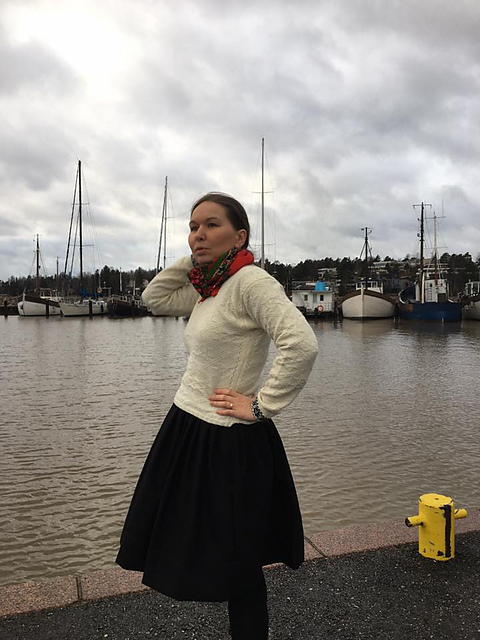Pealkiri võib tunduda veider. Postitus on pikk! Traditsioonilised kudumid pole minu eriala. Siiski huvitab mind n-ö konstruktiivne pool: kuidas kudumeid on konstrueeritud ja mis on muutunud (või ei ole). Raamatus on pisut juttu õmblusteta kudumite ajaloost (paljud traditsioonilised sviitrid on õmblusteta). Selle postituse ajendiks on Dagmari postitus blogis ja Ravelrys. Ta on valmis saanud nn Ruhnu sviitri (rosavamsa), tuginedes ajaloolisele mudelile (blogipostituses on originaali pilt olemas).
The title might appear strange. It is a long post! Traditional knitting is not my field. Still I am interested in the constuctive aspect thereof: namely, how knitwear used to be constructed and how constructions have changed (or not). In my book some space is dedicated to the history of seamless knits (many traditional sweaters are seamless). The idea for this post came from Dagmar's entry on her blog and on Ravelry. She has finished a sweater in the spirit of knitwear tradtion of the Ruhnu island (rosavamsa), baased on the historical model (the photo of the original is on her blog).
Minu arust on pilt väga õnnestunud. Ruhnu vamsad on kootud eraldi tükkidena ja erinevalt teistest meremeeste sviitritest on taljest sisse kootud. Kui seda mitte arvesse võtta, on siluett väga sarnane traditsiooniliste iiri jms kampsunite omaga (inglise keeles võib otsida Aran sweater, fishermens's sweater, gurnsey jms). Nimetatud kampsunid on traditsiooniliselt õmblusteta ja alt üles, erijooneks on kiil kaenla all. Ühes venekeelses allikas leidsin infot ka ülevalt alla kootud iiri sviitri kohta. Kui vene keeles ei loe, saab vaadata pilte. Kahjuks puuduvad viited, oleks huvitav teada, kus niiviisi kooti. Muidugi on hästi palju moodsaid tõlgendusi. Üks hea ülevaade, kuidas kududa traditsiooniline kalamehe sviiter, on siin.
In my opinion the picture has turned out extremely well. Ruhnu vamsa is worked in separate pieces and, differently from other types of traditional fishermen's sweaters, has waist shaping. If we disregared this detail, the shape is very similar to this of traditional Irrish, fishermen's, Aran sweaters. The mentioned sweaters are traditionally worked from bottom to top seamlessly and underarm gusset is their characteristic feature. In a Russian-language source I found information about top-down Irish sweater. If you don't read Russian, the photos help. Unfortunately, there are no references to other sources: it would be instructive to know where this construction was used. Needles to say, there are countless modern interpretations. A good guied how to make a traditional fishermen's sweater is here.
Pildil on hollandikeelse raamatu kaas (Kalameeste sviitrid lastele) (siit). Nüüd milleks kogu jutt? Vaatame Dagmari vamsat lähemalt (pilt tema blogist). Kitsas muster algab õlajoonelt ja läheb alla. See viibki järgmise mõttekäigu juurde.
This is the cover of the Dutch book (Fishermen's sweaters for children) (from here). Why all this story? Let us observe Dagmar's sweater (the picture is from her blog). A narrow pattern starts at the shoulder line and goes down. This brings to the next deliberation.
Minu ripsiga poolpatendis, aga ka muud madala õlajoonega sviitrid on kootud tehniliselt teisiti (ülevalt alla ilma õmblusteta), aga neil on ka see joon. Viimasel ajal meeldib mulle selle konstruktsiooni puhul kududa rohkem silmuseid ripskoes (rea alguses ja lõpus 2-3 s). Kui hiljem kududa otsa varrukad, siis tekib ilus kontrast. Võib olla ka väike palmik, vikkel jms. Küljemusterid olen aga teinud alati. Selle tegumoe puhul ongi loogiline teha esi- ja seljatüki äärel midagi, mis jätkuks ka külgedel. Niisiis, siin on teile ka mitte-ajalooline kudumine!
My half-patent and garter stitch sweaters and also other sweaters with low shoulder line are constructed in a different way (top-down and seamlessly), but they have this feature as well. Recently I have been feeling like knitting more stitches in garter (2-3 sts in the beginning and in the end of the row). When stitches for sleeves are picked up later, you get a nice contrast. You can have a narrow cable, twisted stitches an so on. And I have always made the side pattern. In this construction it is rather logical to make something at the edges of the back and front pieces and then to continue the pattern on the side. So here is non-historical knitting for you!
See on lihtne sviiter, tegumood meeldib mulle. Kes tahab, võib teha üleni mustriga Ruhnu või mõnes muus tratitsioonis.
It is a simple sweater and I like the construction. If you want, you can make it all over in a pattern, Ruhnu or any other traditional stitch.



Kommentaare ei ole:
Postita kommentaar